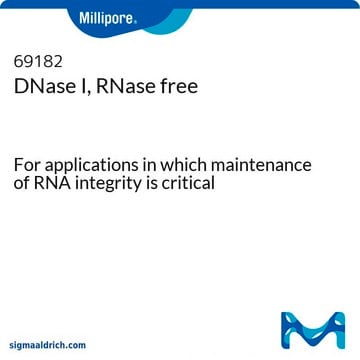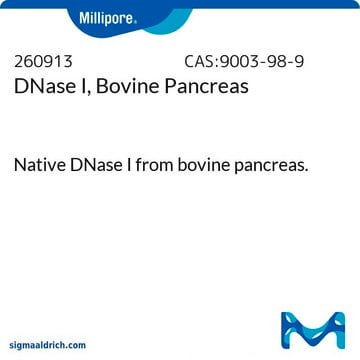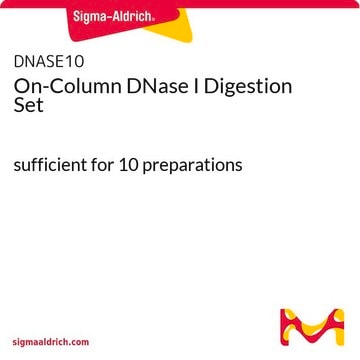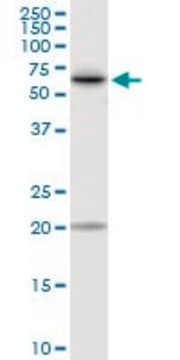AMPD1
DNase I
Amplification Grade
Synonyme(s) :
Deoxyribonuclease I
Se connecterpour consulter vos tarifs contractuels et ceux de votre entreprise/organisme
About This Item
Produits recommandés
Forme
liquid
Concentration
1 unit/μL
Technique(s)
RT-PCR: suitable
Couleur
colorless
Conditions d'expédition
wet ice
Température de stockage
−20°C
Catégories apparentées
Description générale
Deoxyribonuclease I (DNase I) is an endonuclease isolated from bovine pancreas that digests double and single stranded DNA into oligo and mononucleotides. Amplification Grade DNase I has been purified to remove RNase activity, and is suitable for eliminating DNA from RNA preparations prior to sensitive applications, such as RT-PCR (Reverse Transcriptase - Polymerase Chain Reaction).
DNase I digests double- and single-stranded DNA into oligo- and mononucleotides. Using the Reaction Buffer provided, DNA is removed from RNA preparations in a 15 minute digestion at room temperature. The DNase I is then inactivated by heating with the Stop Solution. Heating also denatures hairpins in the RNA, so the RNA can be used directly in reverse transcription.
No current RNA isolation procedure removes 100% of the DNA. Many commercial DNase I formulations are contaminated with residual RNases. This RNase contamination can destroy or degrade valuable RNA samples prior to reverse transcription. Laboratory comparisons have shown that Sigma′s Amplification Grade DNase I demonstrates lower RNase activity than that from several leading molecular biology product suppliers.
DNase I digests double- and single-stranded DNA into oligo- and mononucleotides. Using the Reaction Buffer provided, DNA is removed from RNA preparations in a 15 minute digestion at room temperature. The DNase I is then inactivated by heating with the Stop Solution. Heating also denatures hairpins in the RNA, so the RNA can be used directly in reverse transcription.
No current RNA isolation procedure removes 100% of the DNA. Many commercial DNase I formulations are contaminated with residual RNases. This RNase contamination can destroy or degrade valuable RNA samples prior to reverse transcription. Laboratory comparisons have shown that Sigma′s Amplification Grade DNase I demonstrates lower RNase activity than that from several leading molecular biology product suppliers.
Application
Amplification grade DNase I has been used:
- for the digestion of DNA during isolation and purification of RNA. The purified RNA can be used for the synthesis of cDNA using RNA reverse transcriptase.
- to hydrolyze extracellular matrix (ECM) components and enhance photosensitizer penetration into the biofilm to determine the efficacy of antimicrobial photodynamic therapy (aPDT) on Candida albicans biofilms
- to remove contaminating DNA from total RNA extracted from cattle blood samples
Caractéristiques et avantages
- Suitable for the elimination of DNA from RNA
- Minimal RNase activity available
- Optimized 10× reaction buffer and Stop Solution for complete inactivation of DNase I
Adéquation
Suitable for use in removing DNA from RNA preparations.
Définition de l'unité
One unit completely digests 1 μg of plasmid DNA to oligonucleotides in 10 min. at 37 °C.
Informations légales
Purchase of this product is accompanied by a limited license for use in the Polymerase Chain Reaction (PCR) process for research purposes only and in conjunction with a thermal cycler whose use in the automated performance of the PCR process is covered by an up-front license fee, either by payment to Applied Biosystems or as purchased, i.e., and authorized thermal cycler.
Inhibiteur
Réf. du produit
Description
Tarif
Produit(s) apparenté(s)
Réf. du produit
Description
Tarif
Code de la classe de stockage
10 - Combustible liquids
Point d'éclair (°F)
Not applicable
Point d'éclair (°C)
Not applicable
Certificats d'analyse (COA)
Recherchez un Certificats d'analyse (COA) en saisissant le numéro de lot du produit. Les numéros de lot figurent sur l'étiquette du produit après les mots "Lot" ou "Batch".
Déjà en possession de ce produit ?
Retrouvez la documentation relative aux produits que vous avez récemment achetés dans la Bibliothèque de documents.
Les clients ont également consulté
Xian-Jun Liang et al.
Molecular vision, 18, 1649-1657 (2012-07-10)
Vascular endothelial growth factor (VEGF) is the most potent angiogenic mitogen, and has been associated with angiogenesis. Heparanase is an endoglycosidase that specifically cleaves heparan sulfate side chains, which can induce VEGF expression. The aims of the present study were
Ekene Nweke et al.
Oncology letters, 19(6), 4133-4141 (2020-05-10)
Pancreatic ductal adenocarcinoma (PDAC) is one of the most lethal cancer types, and it is associated with a 5-year survival rate of <10% due to limited early detection methods and ineffective therapeutic options. Thus, an improved understanding of the mechanisms
John P Dunbar et al.
Toxins, 12(6) (2020-06-24)
The noble false widow spider Steatoda nobilis originates from the Macaronesian archipelago and has expanded its range globally. Outside of its natural range, it may have a negative impact on native wildlife, and in temperate regions it lives in synanthropic
Molecular characterization and differential mRNA expression profiling of Toll-like receptor-2 gene in Vechur (Bos indicus) and crossbred (Bos indicus X Bos taurus) cattle of Kerala in response to anthrax vaccination
Shivakumara P N, et al.
Meta Gene, 16, 15-20 (2018)
Hafid Ait-Oufella et al.
The Journal of experimental medicine, 207(8), 1579-1587 (2010-07-07)
B cell depletion significantly reduces the burden of several immune-mediated diseases. However, B cell activation has been until now associated with a protection against atherosclerosis, suggesting that B cell-depleting therapies would enhance cardiovascular risk. We unexpectedly show that mature B
Notre équipe de scientifiques dispose d'une expérience dans tous les secteurs de la recherche, notamment en sciences de la vie, science des matériaux, synthèse chimique, chromatographie, analyse et dans de nombreux autres domaines..
Contacter notre Service technique












